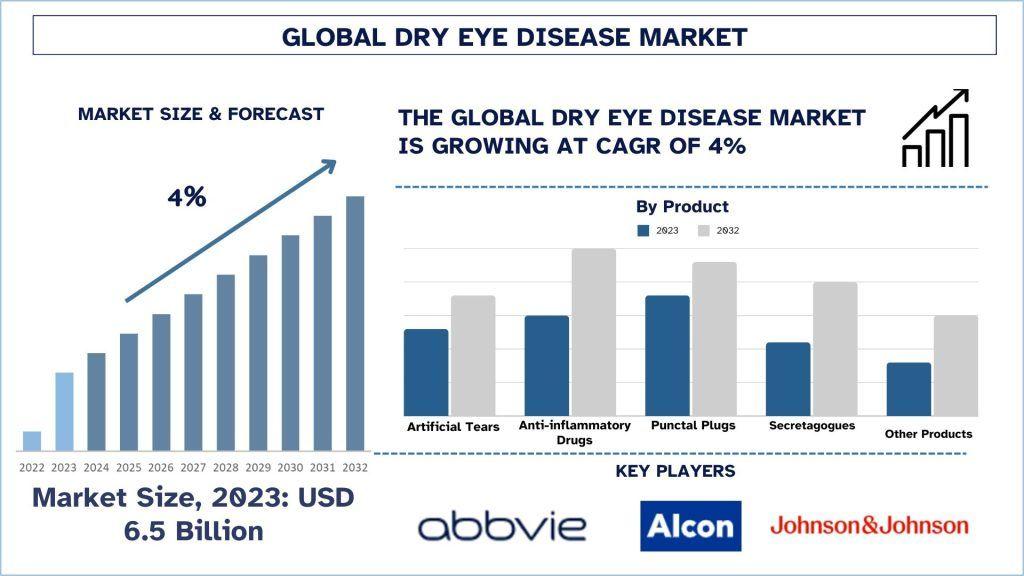Dry Eye Disease Market, Growth, Size, Share, Trends and forecast (2024-2032)

According to a new report by Univdatos, the Dry Eye Disease Market is expected to reach USD 9 Billion in 2032 by growing at a CAGR of ~4%.
Key Highlights of the Report:
Growing cases of Dry Eye Disease: The growing prevalence of dry eye disease is driving the higher demand for dry eye disease-targeting therapeutics in the market.
Rising adoption of personalized medicine in the market: The increasing adoption of personalized medicine is boosting the market.
Growing investments in the R&D sector: The dry eye disease market is experiencing significant growth due to the increasing investments in the R&D sector.
Dry Eye Disease (DED) is a prevalent and often chronic condition affecting millions of individuals worldwide. Characterized by a lack of sufficient lubrication and moisture on the surface of the eye, DED can cause discomfort, visual disturbances, and potentially lead to damage of the eye’s surface if left untreated. It is a multifactorial disease, influenced by various factors such as aging, hormonal changes, environmental conditions, and lifestyle choices. The market is driven by the increasing prevalence of dry eye disease, advancements in treatment options, and heightened awareness about the disease. For instance, as per the data of America Academy of Ophthalmology, approximately 20 million people in the United States are currently living with dry eye disease (DED), and that number is growing in both young and old adults. Further, about 250 million people are living with dry eye disease.
Therapeutic Landscape of Dry Eye Disease
The therapeutic landscape of dry eye disease encompasses a range of treatments aimed at alleviating symptoms, improving tear production, and addressing underlying causes.
1. Over-the-Counter (OTC) Treatments:
· Artificial Tears: These are the most commonly used OTC products and come in various formulations such as aqueous, lipid-based, and gel-based drops. They provide temporary relief by lubricating the eye surface.
· Lubricating Gels and Ointments: Thicker than artificial tears, these provide longer-lasting relief, especially useful for nighttime use.
· Eyelid Hygiene Products: Solutions and wipes designed to clean the eyelids and reduce inflammation, particularly helpful for patients with blepharitis.
2. Prescription Medications:
Anti-inflammatory Agents:
· Cyclosporine A (Restasis): An immunomodulator that reduces inflammation and increases tear production in patients with chronic dry eye.
· Lifitegrast (Xiidra): An integrin antagonist that reduces inflammation by inhibiting T-cell activation and migration.
· Corticosteroids: Short-term use of topical corticosteroids can reduce severe inflammation and provide rapid relief, though long-term use is limited due to potential side effects.
· Autologous Serum Eye Drops: These are made from the patient's own blood serum and contain growth factors and nutrients that promote healing of the ocular surface.
Access sample report (including graphs, charts, and figures) - https://univdatos.com/reports/dry-eye-disease-market?popup=report-enquiry
3. Punctal Plugs:
Temporary and Permanent Plugs: These are small devices inserted into the tear ducts to block drainage and retain moisture on the eye surface. Temporary plugs are often used as a trial before considering permanent options.
4. Advanced Therapeutics:
· Regenerative Medicine:
Amniotic Membrane Transplantation: Used for severe cases, the amniotic membrane provides anti-inflammatory and healing properties when applied to the ocular surface.
· Neurostimulation Devices:
Intranasal Tear Neurostimulator: Devices like TrueTear stimulate the lacrimal gland to increase natural tear production through gentle electrical pulses.
5. Innovative Drug Delivery Systems:
· Liposomal Eye Drops: These enhance drug absorption and prolong contact time on the ocular surface, providing longer-lasting relief.
· Hydrogel Formulations: These advanced formulations offer sustained release of therapeutic agents, improving efficacy and patient compliance.
Conclusion
In conclusion, the evolving landscape of dry eye disease therapeutics reflects ongoing advancements in understanding disease mechanisms and developing targeted treatment approaches. From traditional anti-inflammatory medications to cutting-edge biologic and targeted therapies, the field continues to expand with the promise of improving outcomes for patients living with these eye conditions.
Key Offerings of the Report
Market Size, Trends, & Forecast by Revenue | 2024−2032
Market Dynamics – Leading Trends, Growth Drivers, Restraints, and Investment Opportunities
Market Segmentation – A detailed analysis by Product, Distribution Channel, and Region
Competitive Landscape – Top Key Vendors and Other Prominent Vendors
Contact Us:
Email - contact@univdatos.com
Website - www.univdatos.com
- AI
- Vitamins
- Health
- Admin/office jobs
- News
- Art
- Causes
- Crafts
- Dance
- Drinks
- Film
- Fitness
- Food
- Jogos
- Gardening
- Health
- Início
- Literature
- Music
- Networking
- Outro
- Party
- Religion
- Shopping
- Sports
- Theater
- Wellness


